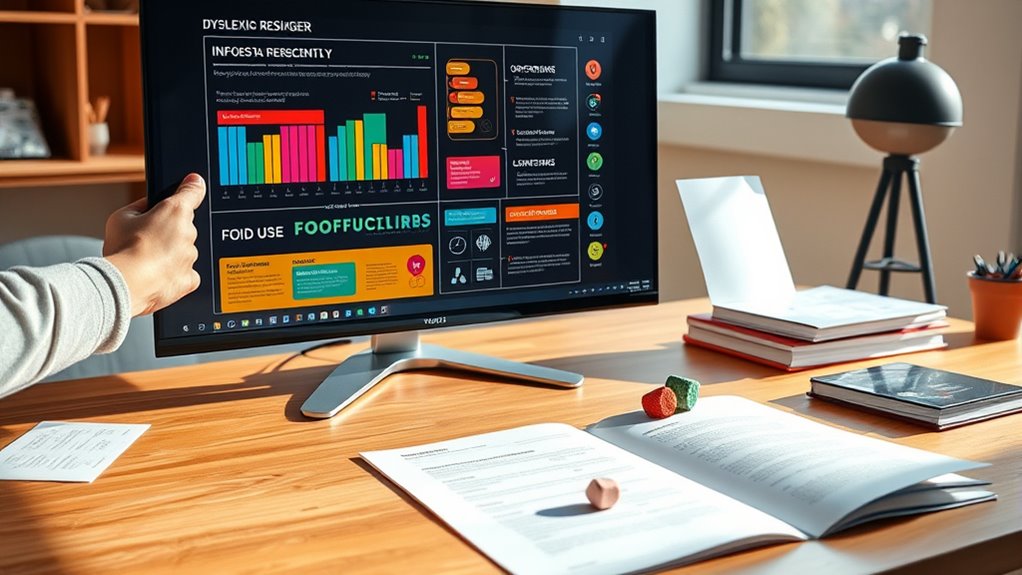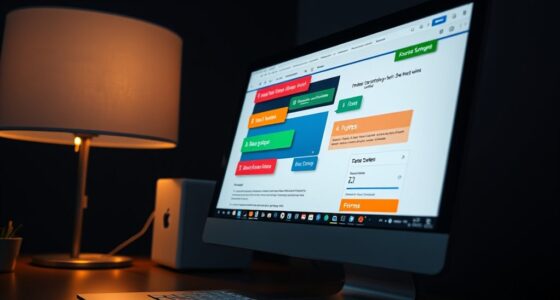When designing for dyslexia, choose fonts like Dyslexie or OpenDyslexic that are easy to read and reduce letter confusion. Use clear headings, short sections, and limit paragraph lengths to make content easy to scan and understand. Apply high contrast colors and simple graphics to support comprehension. Test your design with real users and refine it based on their feedback. Keep exploring for practical tips to create truly accessible and inclusive materials.
Key Takeaways
- Use dyslexia-friendly fonts like Dyslexie or OpenDyslexic, with slight adjustments to letter spacing for better readability.
- Structure content into short, clear sections with descriptive headings and limited paragraph length.
- Ensure high contrast between text and background, opting for soft, eye-friendly color schemes.
- Incorporate simple, supportive visuals and interactive graphics to aid comprehension and engagement.
- Test designs with dyslexic users, gather feedback, and iteratively refine for improved accessibility and usability.
Choosing Readable and Dyslexia-Friendly Fonts
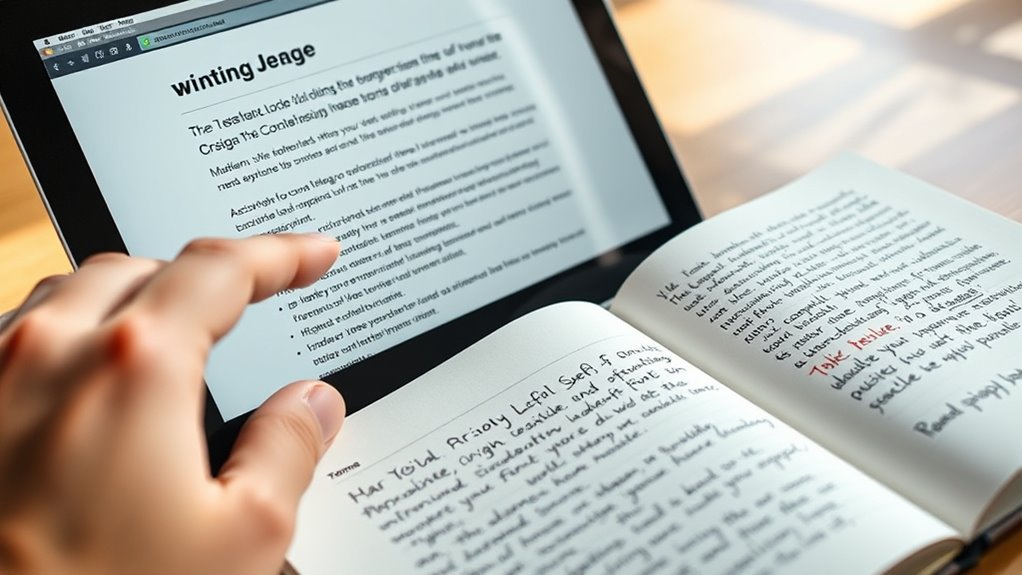
Have you ever noticed how some fonts make reading easier for people with dyslexia? Choosing the right fonts is essential for readability. Look for fonts designed specifically for dyslexic readers, like Dyslexie or OpenDyslexic, which help reduce letter confusion. When selecting fonts, consider font pairing—combining a dyslexia-friendly font with a simple, complementary typeface can improve overall clarity. Pay close attention to letter spacing; increasing it slightly can prevent letters from blending together and enhance legibility. Market demand influences the popularity and effectiveness of certain fonts, so staying informed can help in making better choices. Avoid overly decorative or condensed fonts that may hinder reading fluency. Remember, the goal is to create a clean, accessible reading experience, so opt for fonts that promote comfort and ease of recognition. Proper font choices set the foundation for effective, inclusive design. Additionally, understanding cybersecurity vulnerabilities can help protect digital reading tools and ensure safe access to accessible content. Incorporating typography best practices can further optimize readability and support diverse learners. Recognizing how technology integration can enhance the accessibility of reading materials is also crucial for inclusive education.
Structuring Content for Clarity and Ease of Navigation

Ever wonder how to make your content more accessible for readers with dyslexia? Structuring content clearly helps users find information quickly. Use text chunking by breaking content into short, focused sections, making it easier to process. Incorporate interactive navigation, like menus or clickable headings, so users can move seamlessly through your site. Use a table to organize key tips:
| Tip | Benefit |
|---|---|
| Break text into small chunks | Improves readability and focus |
| Use clear headings | Guides navigation and understanding |
| Add interactive menus | Facilitates easy movement through content |
| Limit each paragraph | Reduces cognitive load |
| Use consistent structure | Builds familiarity and confidence |
This setup ensures your content is easy to scan and navigate, making it more accessible for everyone. Additionally, applying principles of content structuring can greatly enhance clarity and user experience. For example, content organization techniques can help create a logical flow that benefits all readers.
Employing Color and Contrast Effectively
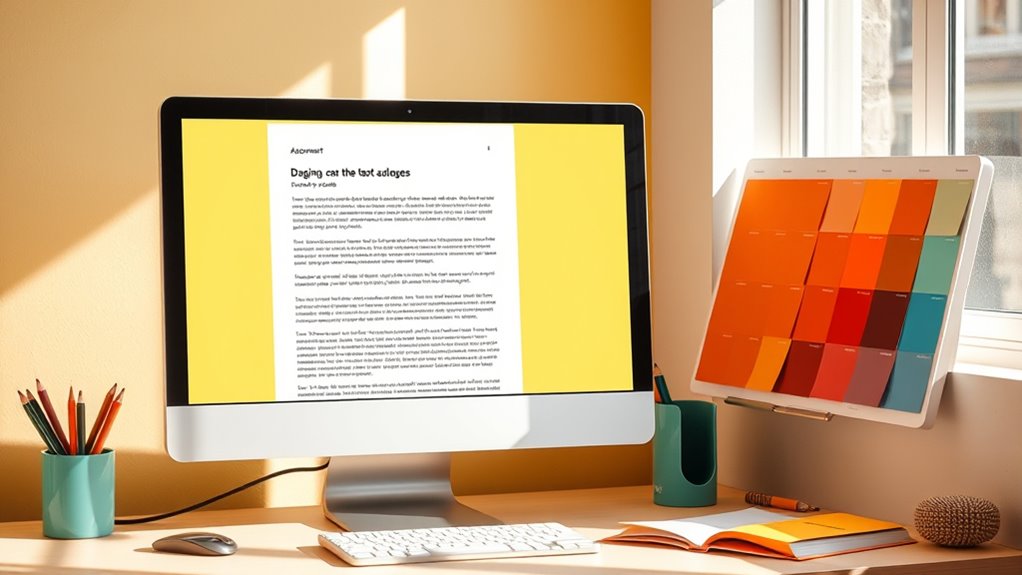
Using color and contrast thoughtfully can substantially enhance readability for readers with dyslexia. Choosing appropriate color schemes helps reduce visual stress and improves focus. Effective contrast strategies ensure text stands out clearly from its background, making it easier to read. To optimize your design, consider these tips:
Thoughtfully using color and contrast can greatly improve readability for readers with dyslexia.
- Use high contrast between text and background, like dark text on a light background.
- Avoid overly bright or saturated colors that can cause visual fatigue.
- Select color schemes that are gentle on the eyes, such as soft blues or muted tones.
- Limit the use of multiple colors within a single block of text to prevent distraction.
- Test contrast levels with tools to ensure accessibility and readability.
- Incorporating environmental considerations, like appropriate lighting and minimal visual clutter, can further improve reading ease.
- Paying attention to visual stress factors in your design can help prevent fatigue and discomfort for readers with dyslexia.
- Additionally, selecting appropriate color contrasts based on established guidelines can significantly improve overall readability and reduce strain.
- When designing for accessibility, consider the impact of surrounding visual elements that may distract or overwhelm the reader.
- Regularly gathering user feedback from individuals with dyslexia can help refine your designs to maximize comfort and readability.
Implementing these contrast strategies makes your content more accessible and easier to process for readers with dyslexia.
Utilizing Visual Aids and Supportive Graphics
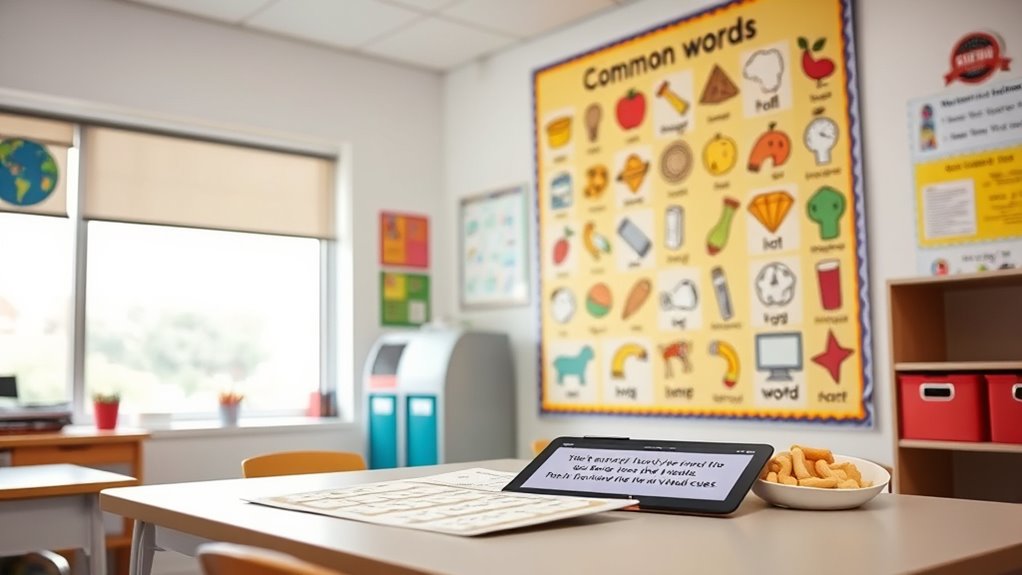
Incorporating visual aids and supportive graphics can considerably enhance comprehension for readers with dyslexia by breaking down complex information into clear, digestible visuals. Use interactive diagrams that allow users to explore concepts at their own pace, which helps reinforce understanding. Animated visuals can add movement and clarity, making abstract ideas more concrete and engaging. These tools turn static text into dynamic learning experiences, reducing cognitive load and improving retention. When designing, guarantee visuals are simple and avoid clutter, so they support rather than distract. Clear labels and consistent styles help users follow along effortlessly. By integrating interactive diagrams and animated visuals thoughtfully, you create accessible content that caters to diverse learning needs, making information more approachable for readers with dyslexia.
Testing and Refining Designs With Real Users
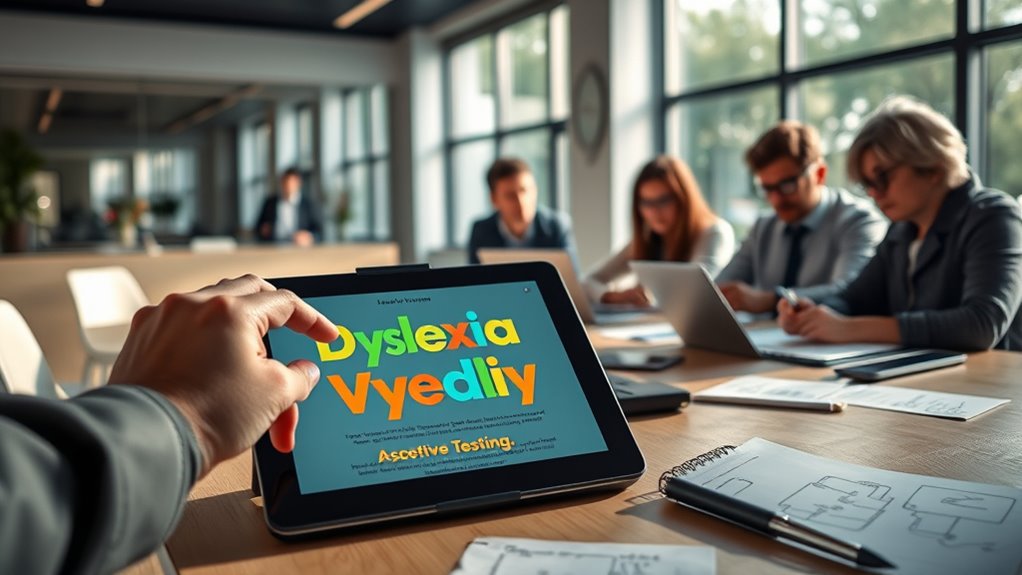
After creating visually accessible designs, it’s vital to test them with real users to see how they perform in practice. User testing reveals how people with dyslexia interact with your designs and highlights areas needing improvement. Embrace an iterative design process, refining your layout based on user feedback. During testing, observe how easily users navigate, comprehend content, and complete tasks. Collect quantitative data, like task completion time, and qualitative insights, such as frustrations or confusion. This approach helps you identify issues early and adapt your design accordingly. Incorporating Mazda Tuning principles can inspire innovative ways to optimize your design’s performance and user experience. Additionally, understanding dyslexia and how it affects reading can guide your testing focus and improvements. Recognizing the importance of inclusive design ensures your solutions accommodate diverse user needs. Remember, continuous testing and refinement ensure your final product truly supports dyslexic users. Keep testing, iterating, and improving to create accessible, effective designs that genuinely meet users’ needs.
Frequently Asked Questions
How Can I Ensure My Design Is Accessible for Multiple Learning Styles?
To guarantee your design is accessible for multiple learning styles, you should incorporate multisensory engagement, providing visual, auditory, and tactile elements. This approach supports individualized learning, allowing users to choose methods that suit them best. Use clear visuals, audio options, and interactive features to cater to diverse preferences. By embracing these strategies, you create an inclusive experience that enhances understanding and retention for all users.
What Are the Common Challenges Faced by Dyslexic Users Online?
You might think dyslexic users face only reading difficulties, but they also encounter challenges like visual clutter and navigation confusion. These issues make it hard to focus and find information quickly. You should simplify layouts, reduce unnecessary visuals, and use clear, consistent menus. By addressing these common challenges, you help dyslexic users navigate your site more easily, creating a smoother, more inclusive online experience.
How Does Font Size Impact Readability for Dyslexic Individuals?
You should know that font size greatly impacts reading ease for dyslexic individuals. Larger fonts make text more legible and reduce eye strain, helping you process information faster. Small font sizes can cause difficulty and frustration, hindering comprehension. By choosing an appropriate font size, you create a more accessible experience, ensuring your audience can read comfortably without unnecessary effort. Prioritizing adequate font size supports better readability for everyone, especially those with dyslexia.
Are There Specific Tools to Test Dyslexia-Friendly Website Designs?
Think of tools for testing dyslexia-friendly websites as your lighthouse in a foggy sea. You can use accessibility testing tools like WAVE, AXE, or Lighthouse to evaluate your site’s readability and accessibility. Additionally, conducting dyslexia screening with specialized software helps identify design elements that might challenge dyslexic users. These tools guide you in making informed improvements, ensuring your website shines brightly for everyone.
How Can I Incorporate User Feedback Effectively Into Design Improvements?
You can incorporate user feedback effectively into your design improvements by actively seeking it through surveys, interviews, and usability testing. Prioritize feedback related to accessibility and readability, especially from users with dyslexia. Use an iterative design process, making small adjustments based on their insights. Continuously test and refine your website, ensuring it becomes more inclusive and user-friendly with each cycle. This approach helps you create a more accessible experience that truly meets user needs.
Conclusion
By applying these best practices, you’re well on your way to creating more accessible designs. But remember, the journey doesn’t end here. Each user interaction offers new insights, revealing what truly works—and what doesn’t. Are you ready to uncover the hidden challenges that still lurk in your design? Keep testing, refining, and listening. The future of dyslexia-friendly design depends on your willingness to adapt and innovate. The next breakthrough could be just around the corner.
